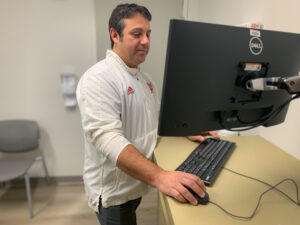Ice or heat: What you should know about pain relief
Expert: Dr. Patrick Siparsky, IU Health orthopedic surgeon located at Methodist Medical Plaza North
Whether you face an injury to your bone or muscle or even arthritis in your joints, orthopedic experts are ready to help. However,

slight to moderate pain does not always require a trip to see your doctor. In certain situations, an ice pack or heating pad can help you feel better more quickly. But it is important to know which to use in which situation to prevent further pain or even injury.
When should you use cold therapy?
Cold therapy, such as a cold compress, should typically be used for recent injuries that have occurred within the last 48 hours and in which swelling is a problem. Apply the ice pack or even a bag of frozen food from the freezer to the injury. Make sure to wrap the frozen item in a towel or some kind of cloth. Applying a very cold item directly to your injury can cause damage to the skin and tissue. Make sure you use cold therapy as quickly as possible after the injury occurs, but only use it for short periods of time throughout the day. Stick to around 10 to 15 minutes at a time to prevent damage to your nerves, tissue and skin. For best results, elevate the injured area while using cold therapy.

When should you use heat therapy?
Heat therapy should be used if you have pain or stiffness in your joints or muscles. Ten to 15 minutes of heat therapy can help relieve minor pain. Moderate to severe stiffness or tension can be helped with a longer session, such as a hot bath. For this level of pain, you can apply heat therapy from 30 minutes to up to two hours. A bath or outdoor saunas can also be used to treat full body pain. Small heat packs can be used on smaller areas of pain. For larger areas, you can use a larger heating pad, heat wraps or even a heated towel.
When should you avoid cold or heat packs?
Do not use cold therapy or heat therapy for open wounds, rashes or infections. Consult your doctor on other pain relief methods if you have poor sensation to heat or cold, if you have poor circulation or if you have been diagnosed with diabetes.
What should you do if the treatment doesn’t work?
If cold therapy or heat therapy does not work or makes your pain worse, immediately contact your physician to discuss other treatment options. You should also let your doctor know if you develop any bruising or skin changes after using cold or heat packs.
When should you see a doctor for pain instead?
If you have severe or persistent issues with your upper body, including the shoulder, elbow, wrist and hand, or the lower body, including hips, knees, ankles and feet, it’s time to consult a physician.
IU Health can help treat your muscle and joint pain so you can move through life at your own pace. Our orthopedics experts are here to help you. For more information or to find an orthopedic specialist near you, visit iuhealth.org/orthopedics.






